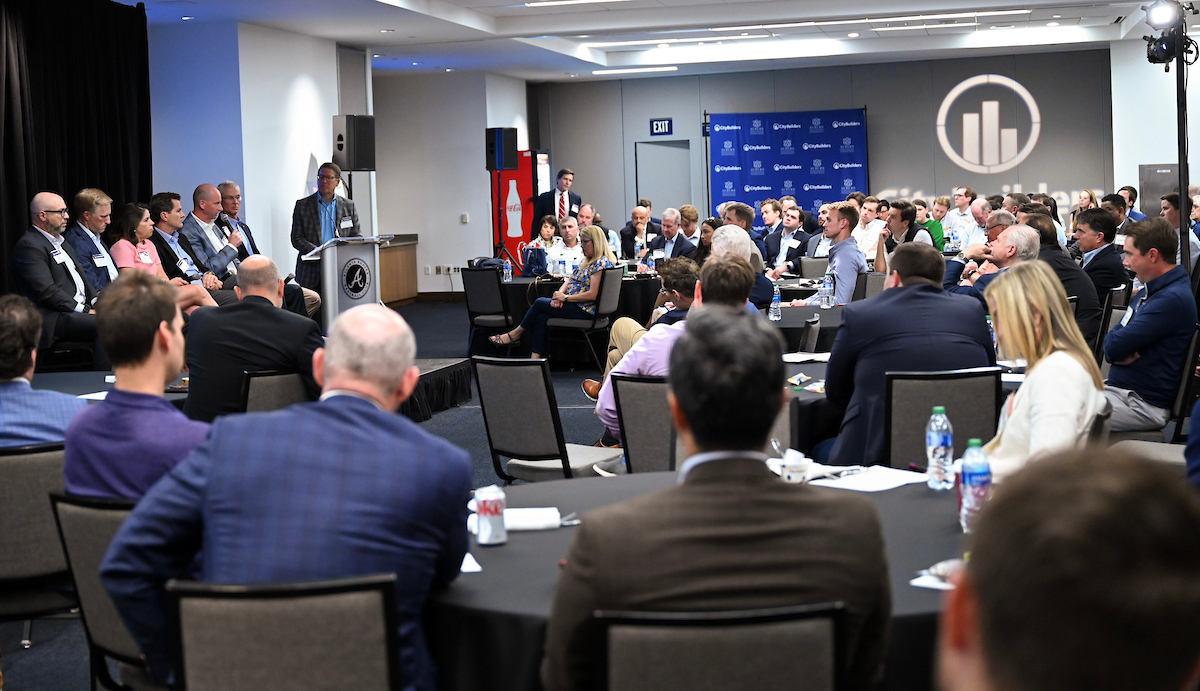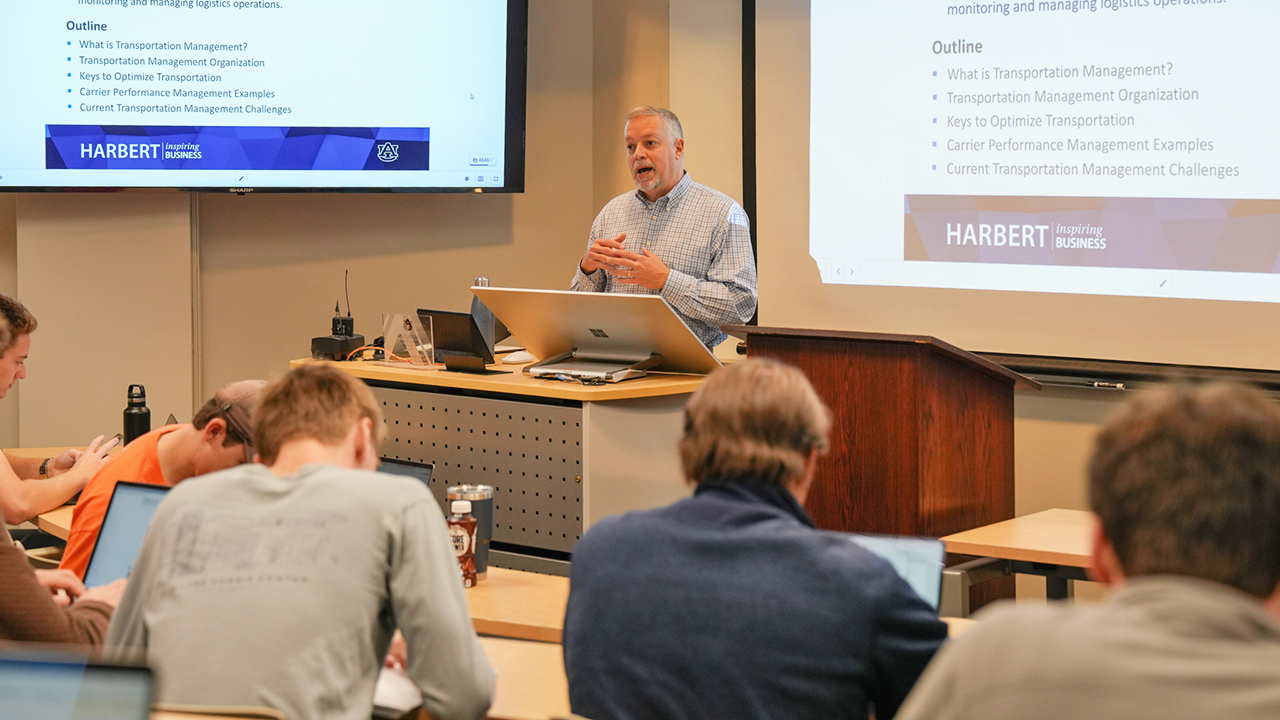 |
The CityBuilders 2023 Symposium in Atlanta brought together Auburn Institute for Real
Estate Development faculty and 180 industry professionals to explore challenges and
opportunities in the industrial real estate market. Photo by Julie Bennett
|
CityBuilders, an initiative of Auburn University’s newly formed Institute for Real Estate Development and number one-ranked Master of Real Estate Development (MRED) program, recently held its fourth annual symposium in Atlanta exploring challenges
and opportunities in the industrial real estate development market.
The Future of Industrial Development and Logistics event featured a broad spectrum of real estate developers, financers and supply chain
experts sharing their insight on the dramatic changes in global supply chains and
logistics brought on by the COVID-19 pandemic and how those issues impact industrial
real estate development across the country.
This year’s gathering was co-hosted by the Center for Supply Chain Innovation at Auburn and David Welch, CEO of Robinson Weeks Partners, an Atlanta-based, privately held industrial real estate development and investment
firm that funds and structures joint ventures to develop speculative industrial buildings,
multi-phased projects and customized build-to-suit projects throughout the United
States.
Held at Truist Park, home of the Atlanta Braves, the event was attended by 180 industry
professionals from across the south who listened to presentations by leading industrial
development experts and Auburn faculty and participated in three panel discussions
on the outlook for supply chain-related real estate projects, the availability of
financing options and how developers are responding. They also enjoyed a networking
event during the game between the Atlanta Braves and Philadelphia Phillies on the
Xfinity Rooftop Deck overlooking the field.
Setting the Stage
Justin Benefield, director of Auburn’s MRED program, and Kim Kuerten, executive director of Graduate Executive Programs at the Harbert College of Business,
welcomed the attendees and highlighted the extraordinary collection of industry leaders
on hand to help drive home the importance of integrating top-tier academic research
and education with real-world business experience.
“As every real estate professional knows, numbers matter,” remarked Benefield, “and
I just want to start off by saying how grateful we are to have all the industry experts
we have here with us today – not to mention the prestige of who they are and the organizations
they represent. It truly is impressive, and we thank you for your contributions.”
Kuerten echoed the critical importance of engaging leading real estate industry professionals
in the annual symposium, throughout the year in classrooms at Auburn, as well as during
the MRED program’s signature field trips.
“The dedicated commitment by these industry leaders – many of whom are here today
– brings a wealth of hands-on experience to the MRED program both in the classroom
and during local, national and international trips to visit projects they’ve built
or are in the process of developing,” noted Kuerten. “Their dedicated support of MRED,
the Institute for Real Estate Development and what we have planned going forward is truly remarkable.”
Greg Winchester, head of Industry and Alumni Relations for Auburn’s MRED program and an adjunct professor
at Auburn’s Harbert College of Business, pointed to one of the three pillars of the Institute for Real Estate Development
served by CityBuilders – driving thought leadership for the industry.
Winchester is a seasoned real estate professional who brings more than 40 years of
executive leadership experience in business and non-profit organizations that includes
commercial real estate, banking, financial services, start-ups, industry trade associations,
non-profits, and education.
“When I first came to Auburn, we were trying to figure out how to better connect the
MRED program with the industry,” noted Winchester. “Because of my background and relationships,
I was able to make certain connections and help pull together some of the experts
we have here today. The extraordinary breadth and depth of experience, expertise and
insight in this room is a testament to how important the Institute is becoming for
Auburn, the MRED program and the real estate development industry itself.”
The collective mission and collaborative efforts of the Harbert College of Business,
the College of Architecture, Design and Construction, the Center for Supply Chain
Innovation and the Institute for Real Estate Development is a singular one, says Winchester
– “to bring the industry to the university and the university to the industry.”
Opportunities Abound – Despite Economic, Supply Chain Challenges
The market for real estate development was hit hard by the COVID-19 pandemic and lockdowns,
with lasting repercussions ranging from supply chain bottlenecks for critical building
materials to the collapse of traditional financing instruments due to bank failure
repercussions and the unprecedented rapid pace of interest rate increases.
The commercial real estate market was impacted the most, in large part due to the
work-from-home practices instituted during the pandemic which have resulted in a seismic
transformation in where and how employees work. While residential housing development
continued largely unscathed, the commercial office market collapsed, with virtually
all in attendance agreeing that segment will likely take years to recover.
 |
Following the symposium, participants enjoyed a networking event at the Atlanta Braves
baseball game. Photo by Julie Bennett
|
The good news is that industrial development projects – particularly those that address
the dramatic shift in supply chain management – are still promising, although even
these projects are up against significant challenges from a financing perspective.
And yet, “developers are an optimistic group of people, otherwise you wouldn't be
a developer,” says Welch. “We’ve come off one of our best years ever last year – and
the supply-demand fundamentals are in great shape, with record low vacancy. While
there is a record amount of construction underway in most markets this year, demand
should be strong enough to absorb most of these deliveries leaving our markets in
very good shape by year end.”
Lance Patterson, founder & CEO of Patterson Real Estate Advisory Group and one of the participants in the Capital and Credit Providers panel, took a slightly
more cautious, yet still positive, tone.
“We’re coming out of the worst financial environment since 2008, but deals are possible,” said Patterson. “They just have to be structured to make financial sense
for all stakeholders – the financers, developers, their clients and the communities
in which these projects will be located.”
The sweet spot for industrial development projects is the demand for large manufacturing
facilities, warehouses and distribution centers located near a widening array of U.S.
ports of entry and export. This heightened demand has its roots in the U.S.’s decades-long
reliance on foreign-made products, just-in-time inventory practices and the monumental
transition to near-sourcing strategies and facilities as a result of the pandemic.
The unprecedented delays experienced in getting freight in and out of major ports
of entry like Los Angeles, Long Beach, San Francisco, Oakland and Seattle on the West
Coast served to increase traffic at smaller ports in the Gulf and on the Atlantic
Seaboard like Savannah, Charleston and Mobile, forcing manufacturers, retailers and
other suppliers to rethink their approaches to where their distribution facilities
are located.
A similar phenomenon is happening on our southern border, where the shift to new and
expanding manufacturing operations sited in Mexico over the past few years is taxing
available warehousing and distribution capacity on the U.S. side.
Land adjacent to these ports and border crossings has become scarce, especially property
capable of accommodating the size of the development projects needed – many of which
reach more than a million square feet or more.
The result, according to the experts who spoke at this year’s CityBuilders, is that
major importers and exporters like Amazon, Walmart and Target have been building warehouses
and distribution centers up to an hour’s drive inland along major transportation routes
leading in and out of these formerly “alternative” ports. Others are following that
trend, which is projected to continue.
Beyond Availability
It isn’t just the dearth of suitable plots – which is challenging unto itself – the
cost of acquiring the land and building the infrastructure to handle these sprawling
facilities is more expensive than many might expect. Pulling together multiple small
plots into a single large one is difficult and the process is laden with practical
obstacles that take time and money to overcome.
Many landowners in these rural areas have owned their land for decades or more and
are in no hurry to sell. The mortgages on their land were paid off years ago – there’s
no urgency for them to sell unless they get the price they are looking for.
And the difficulties don’t end there. A typical million square foot distribution center
could employ up to 2,000 workers or more, but where will they come from? Where will
they live? Where will they shop for groceries and other essentials? Where will their
children go to school? These are all considerations that industrial developers have
to contend with when trying to build in unincorporated, sparsely populated areas.
Additional challenges include building or expanding roads, developing or improving
rail stops, and revising zoning laws and permits. Again, the time and money required
to work through these issues increase accordingly, and these factors weigh heavily
in the site selection process well before the first shovel of dirt is lifted at groundbreaking.
Finally, many communities simply don’t want these developments, despite the economic
benefits and tax revenue they may bring. Disruptions like traffic delays from road
construction projects, the impact of hundreds of dump trucks and semi-tractor trailers
rumbling through their towns and overcrowded local retail stores and restaurants can
make negotiations at the local government level a heavy lift.
Symposium panels and sponsors
That’s where the three panels at this year’s CityBuilders Symposium delivered the
kind of real world, practical insight attendees found most valuable. We will dive
deeper into each of these panel discussions—Current Landscape and Outlook for Logistics and E-Commerce, Capital and Credit Providers, and Meet the Developers—through follow-up articles in the coming weeks.
In closing, everyone involved in this year’s Symposium would like to thank the sponsors
who helped make it all possible:
Signature Sponsors: Bradley, Friends of MRED, Regions Bank, Robinson Weeks Partners,
TerraCap, Trimont, and Warren & Kimberly Jolly
Senior Sponsors: Blue Steel Development and Carlton Fields
Supporting Sponsors: Beauxwright, DHL, Physicians Realty Trust, Pinnacle Financial
Partners, Raymond James, Realty Trust, Ronald Blue Trust, Summit Investors, Taylor
& Mathis, Truist, and Voya Financial

 Degrees & Programs
Degrees & Programs
 Faculty & Staff
Faculty & Staff
 Career Development
Career Development
 Recruiters & Industry
Recruiters & Industry




